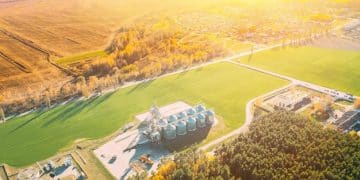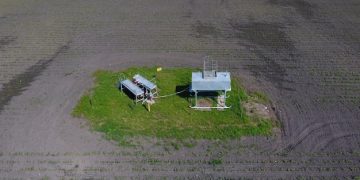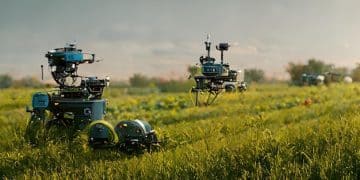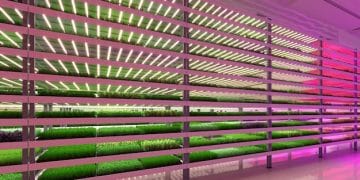Precision Agriculture in the US: Demand Surge and 2025 Outlook

Understanding the Surge in US Demand for Precision Agriculture Technologies: A 2025 Outlook reveals a significant increase in the adoption of advanced farming techniques, driven by the need for efficiency, sustainability, and increased yields in the face of growing global food demand and environmental concerns.
The agricultural sector in the United States is undergoing a technological revolution, marked by a notable increase in the demand for precision agriculture technologies. As we approach 2025, understanding the factors driving this surge is crucial for stakeholders across the industry.
Drivers Behind the Demand Surge
Several factors are converging to fuel the increased demand for precision agriculture technologies in the US. These include the need to optimize resource utilization, enhance crop yields, and improve overall farm management practices.
Resource Optimization
One of the primary drivers is the increasing pressure to optimize the use of resources such as water, fertilizers, and pesticides. Precision agriculture enables farmers to apply these inputs more efficiently, reducing waste and minimizing environmental impact.
Yield Enhancement
Another critical factor is the need to enhance crop yields to meet the growing global food demand. By precisely monitoring and managing crops, farmers can identify and address issues early, leading to higher yields and improved quality.
- Data-driven decision-making.
- Real-time monitoring of crop health.
- Remote sensing technologies
In conclusion, the optimization of resource utilization and the increase in crop yields are important motivators behind this transformation in the agricultural field.

Key Technologies Driving Precision Agriculture
Precision agriculture encompasses a range of innovative technologies that are transforming traditional farming practices. These technologies include GPS-based guidance systems, remote sensing, variable rate application, and data analytics.
GPS-Based Guidance Systems
GPS-based guidance systems enable farmers to navigate fields with greater precision, ensuring accurate planting, spraying, and harvesting. This technology reduces overlap and gaps, maximizing efficiency and minimizing input costs.
Remote Sensing
Remote sensing technologies, such as drones and satellite imagery, provide farmers with valuable insights into crop health, soil conditions, and water stress. These data allow farmers to make informed decisions about irrigation, fertilization, and pest control.
- Drones with multispectral cameras.
- Satellite imagery for large-scale monitoring.
- Data analytics for predictive insights.
In conclusion, these technologies enable farmers to optimize their operations, reduce waste, and increase profits, driving further demand for precision agriculture solutions.
The Role of Data Analytics
Data analytics plays a pivotal role in precision agriculture by transforming raw data into actionable insights. Farmers can use data analytics to optimize their operations, predict crop yields, and improve decision-making.
Optimizing Operations
By analyzing data from various sources, farmers can identify patterns and trends that help them optimize their operations. This includes optimizing planting dates, irrigation schedules, and fertilizer application rates.
Predicting Crop Yields
Data analytics can also be used to predict crop yields, allowing farmers to make informed decisions about marketing and sales. By accurately forecasting yields, farmers can minimize waste and maximize profits.
In conclusion, data analisys provides many tools to improve the decisions in the agricultural enviroment.

Government Initiatives and Support
Government initiatives and support programs play a crucial role in promoting the adoption of precision agriculture technologies in the US. These programs provide financial incentives, technical assistance, and educational resources to help farmers invest in and implement these technologies.
Financial Incentives
Government agencies offer various financial incentives, such as grants, loans, and tax credits, to help farmers purchase precision agriculture equipment and software. These incentives can significantly reduce the financial burden of adopting new technologies.
Technical Assistance
Technical assistance programs provide farmers with expert guidance on how to implement and use precision agriculture technologies effectively. These programs offer training, workshops, and on-site support to help farmers overcome technical challenges and maximize the benefits of these technologies.
- USDA programs promoting sustainable agriculture.
- State-level initiatives supporting technology adoption.
- Partnerships with universities and research institutions.
In conclusion, this goverment support can greatly accelerate the adoption of these new technologies.
Challenges and Barriers to Adoption
Despite the numerous benefits of precision agriculture, several challenges and barriers hinder its widespread adoption in the US. These include the high initial investment costs, lack of technical expertise, and concerns about data privacy and security.
High Initial Investment Costs
The initial investment costs associated with precision agriculture technologies can be a significant barrier for many farmers, particularly small and medium-sized operations. The cost of equipment, software, and training can be substantial, making it difficult for some farmers to justify the investment.
Lack of Technical Expertise
Another challenge is the lack of technical expertise among farmers and farmworkers. Precision agriculture technologies require a certain level of technical knowledge and skills, which many farmers may not possess. This can make it difficult for them to effectively implement and use these technologies.
- Addressing the digital divide in rural areas.
- Providing accessible training and education programs.
- Ensuring data privacy and security.
Overcoming these challenges will require a collaborative effort from government, industry, and academia to provide farmers with the resources and support they need to adopt precision agriculture technologies successfully.
Future Trends and Innovations
Looking ahead to 2025 and beyond, several emerging trends and innovations are poised to further transform the precision agriculture landscape in the US. These include the integration of artificial intelligence (AI), the development of advanced sensors, and the expansion of the Internet of Things (IoT) in agriculture.
Integration of Artificial Intelligence
The integration of AI is expected to revolutionize precision agriculture by enabling more sophisticated data analysis, predictive modeling, and automated decision-making. AI-powered tools can help farmers optimize their operations, improve crop yields, and reduce costs.
Development of Advanced Sensors
The development of advanced sensors is another key trend that is expected to drive the growth of precision agriculture. These sensors can provide real-time data on a wide range of parameters, including soil moisture, nutrient levels, pest infestations, and disease outbreaks.
This constant monitoring can improve decision-making, reducing losses and increasing growth.
| Key Point | Brief Description |
|---|---|
| 🌱 Efficiency | Improved resource use in farming. |
| 📈 Yield | Increased crop production with targeted methods. |
| 🛰️ Technology | Drones and sensors provide detailed field data. |
| 🤖 AI | AI enhances data analysis for better farming decisions. |
Frequently Asked Questions
▼
Precision agriculture involves using technology to make farming more accurate and efficient. This includes GPS guidance, sensors, and data analytics to optimize crop management.
▼
It is becoming popular due to its ability to improve efficiency, reduce waste, and increase crop yields. Farmers face growing pressures to optimize their farming practices.
▼
The main benefits include higher yields, reduced costs, better resource management, and more sustainable farming practices. It helps both the environment and the farmer.
▼
Challenges include high initial costs, a lack of technical skills, and worries about how data is used. Overcoming these is vital for widespread use.
▼
AI enhances the capacity for farmers to analyze data, forecast crop outcomes, and automate choices, thereby boosting operational effectiveness and productivity on the field.
Conclusion
In summary, the surge in demand for precision agriculture technologies in the US reflects a broader trend towards data-driven, sustainable farming practices. While challenges remain, the potential benefits of these technologies are significant, paving the way for a more efficient and resilient agricultural sector.





